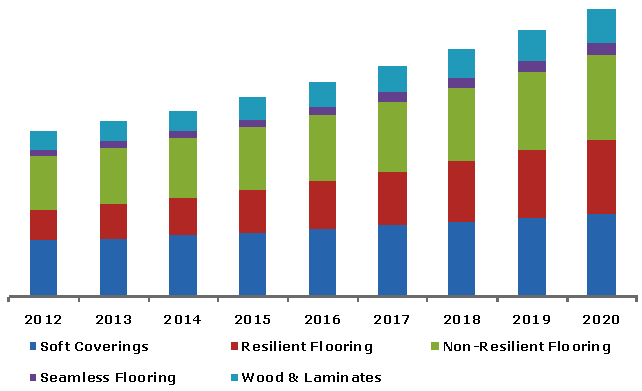The Global Commercial Flooring Market is expected to reach USD 166.63 billion by 2020, according to a new study by Grand View Research, Inc. Technological advancements have led to the development of new innovative products and hassle-free installation techniques, which has considerably widened the scope across residential, commercial and industrial flooring applications. Increasing demand in the construction industry is expected to be the key driving force for the market over the next six years. Development and use of eco-friendly flooring materials such as Polyester (P.E.T) Berber, linoleum, cork, reclaimed hardwood, bamboo, glass, and rubber is expected to positively impact the commercial flooring market.
Raw material costs have had a significant impact on the commercial flooring industry. Along with the issue of transportation cost, manufacturers have to deal with increasing fossil fuels prices as a result of which their margins have shrunk to a large extent. Carpet and resilient flooring are largely derived from fossil fuels.
Global commercial flooring market by product, 2012 – 2020

View summary of “Commercial Flooring Market Analysis Report” @ http://www.grandviewresearch.com/industry-analysis/commercial-flooring-market
Further key findings from the study suggest:
- The resilient category is poised for high growth over the next six years. Vinyl sheets goods are predominantly used in education and healthcare, with the latter accounting for substantial quantity usage of homogeneous sheet in clinical settings. Luxury vinyl tiles (LVT) have made swift penetration in all application sectors. LVT has increasingly replaced vinyl composite tiles (VCT) in back office applications, break rooms, corridors and cafeterias.
- Carpets’ penetration into the commercial flooring sector is higher than that in the residential sector. Although residential carpet primarily comprises broadloom, carpet tiles have made inroads into the commercial sector. Porcelain comprises a majority of the ceramic commercial flooring market owing to its inherent characteristics such as stain resistance and high temperature tolerance. Laminate and hardwood are used in niche commercial flooring applications.
- Commercial offices accounted for a substantial market share in 2013, with significant demand originating from both, owner-occupied spaces and tenant improvement. Healthcare is expected to exhibit high growth potential throughout the forecast period with high demand anticipated from medical office buildings, acute care, and senior living categories. Considerable remodeling activity, particularly in higher-end retail stores is expected to play a pivotal role in high commercial flooring demand from the retail sector.
- Asia Pacific captured a sizable amount of the commercial flooring market in 2013, which can be primarily attributed to growing infrastructure facilities and rapid urbanization in the region. Steady demand from education and healthcare sectors supplementing increasing demand from the corporate section has driven the North American commercial flooring market.
- Key commercial flooring market players such as Armstrong, Forbo, Mohawk, Nora, and Interface Global are constantly evolving and innovating in a bid to maintain competitiveness. Manufacturers have emphasized on developing display and distribution systems to aid consumers in choosing the appropriate product.
Request for free sample of “Commercial Flooring Market Analysis Report” @ http://www.grandviewresearch.com/industry-analysis/commercial-flooring-market/request
